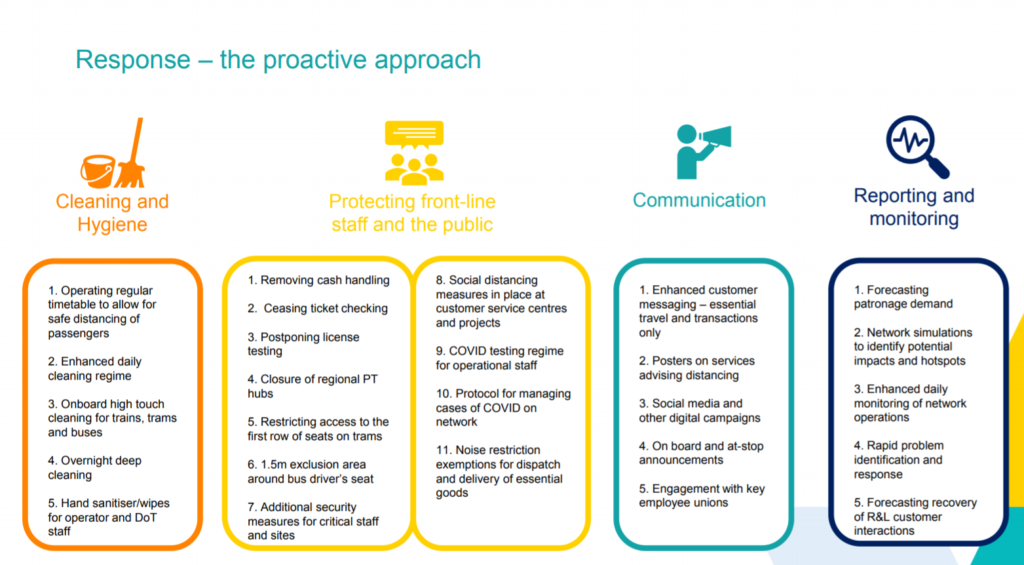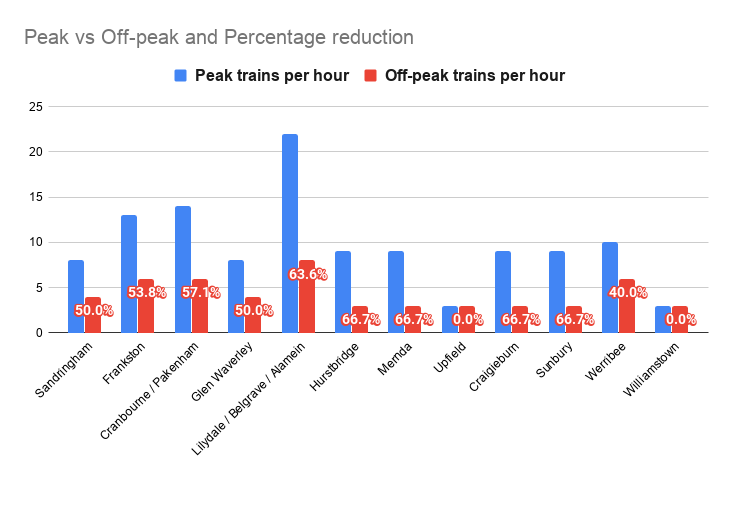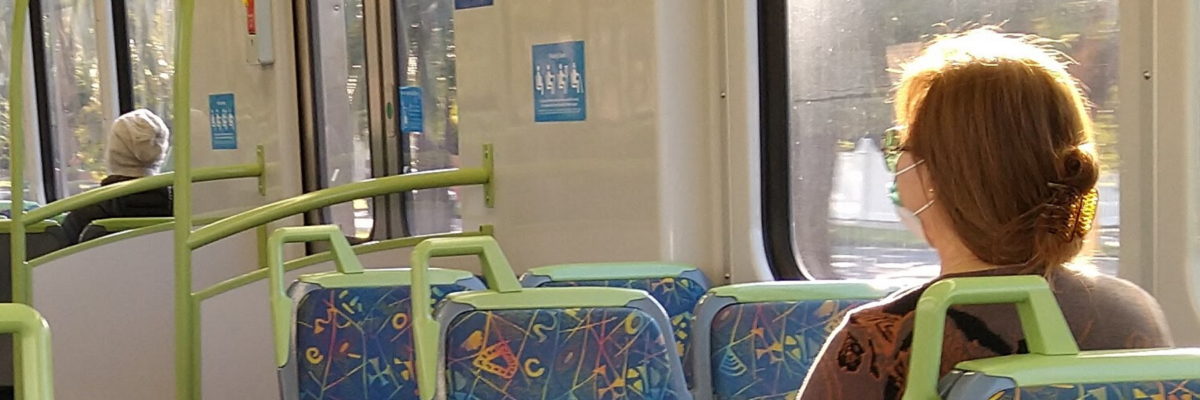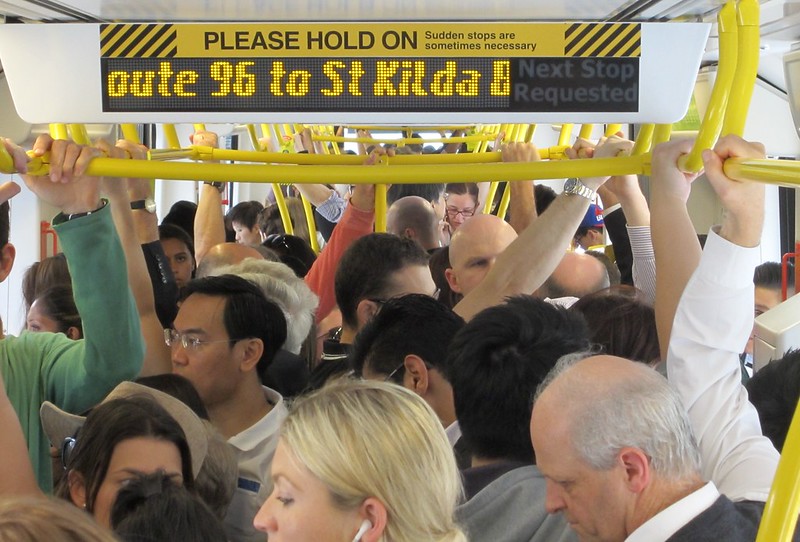I thought I’d cruise the web and see if I could find information on how various cities’ public transport systems worldwide are adapting to COVID-19. This is not an exhaustive list – it’s just a summary from some cities where I could quickly find information.
Obviously it’s important to remember that there are fundamental differences in the overall situation in these cities. We in Australia have it largely under control. The same can’t necessarily be said for Europe and North America.
Some measures are pretty much universal:
- Enhanced cleaning of vehicles, stops and stations – though shortages of cleaning products and staff has meant some networks closing some stations and/or some parts of some stations
- Messages encouraging good hygiene: frequent hand-washing, cough and sneeze etiquette
- Encouraging people not to use the system unless necessary, and to avoid peak hours (stagger trips)
Other measures vary city by city:
| City | Service levels | Hand sanitiser dispensers | Face coverings | Capacity limits | Fares | Boarding |
| New York City MTA | Reduced, including no all-night subway to enable cleaning | Compulsory | No cash transactions at station booths | Rear door boarding of buses | ||
| London TFL | Reduced, in part due to staff availability | Yes, including at all stations | Recommended | No cash except at a few stations Some buses free due to rear door boarding | Rear door boarding of buses while driver screens are improved | |
| Vancouver Translink | Yes | Recommended | Seat markings and capacity limits on buses and Seabus (ferry) | Rear door boarding and free rides were in place, but phased-out from 1st June | ||
| Los Angeles Metro | Reduced service, similar to weekend timetable | Yes | Compulsory | No fare payment expected on buses | Bus rear door boarding | |
| Washington Metro | Reduced service, shorter operating hours. Some stations closed | Compulsory | No fare payment on buses due to rear door boarding | First and last carriage of trains are closed Bus rear door boarding | ||
| Portland Trimet | Reduced service | On vehicles | Compulsory | Bus capacity limits | No cash on buses | |
| Boston MBTA | Modified service, including no ferries | Compulsory | Bus and trolley (tram) rear door boarding | |||
| Seattle/King County Metro | Reduced service | Recommended | No fare payment | Bus rear door boarding | ||
| Chicago CTA | Reduced service | Compulsory | Bus rear door boarding | |||
| Paris RATP | Reduced service, shorter operating hours. Some stations closed | Compulsory | ||||
| Brussels STIB-MIVB | No all-night services | Compulsory | No cash transactions | Bus/tram rear door boarding | ||
| Berlin BVG | Full service | Compulsory | No on-board ticket sales | Bus rear door boarding | ||
| Sydney Transport For NSW | Full service | Yes | No | Use marked seats only to limit capacity | No ticket sales where Opal card is valid | |
| Perth Transperth | Minor changes, eg no late night trains | No | Cash boxes on buses (no change given) Paid station parking temporarily free | Rear door exit where possible | ||
| Adelaide Metro | Reduced bus services to match demand | No | ||||
| Brisbane Translink | Full service | No | No cash accepted except at vending machines | Rear door boarding of buses | ||
| Melbourne PTV | Full service | No | No | No cash accepted except at vending machines | No use of front door on trams, and some buses (varies by operator) |
Face covering rules on public transport rules mostly reflect wider rules in those cities. (Note they mostly refer to face coverings, not masks specifically. Scarves and bandanas are generally considered okay.)
Hard capacity limits only seem to be in place in Vancouver, Portland and Sydney – none of the other cities I looked at are imposing them. Most merely encourage people to maintain distance from others, without enforcing it. (Remember: the above is not an exhaustive list.)
And Melbourne’s response? Here’s a summary, from a presentation given by PTV/DOT to UITP this week:

The public information and advice from PTV is here, and includes advice to keep your distance, practice good hygiene, and to stagger your travel.
Melbourne’s capacity problem
Here in Melbourne, patronage has recovered to about 20% of normal levels. We are told adequate physical distancing requires the system to run at about 15% of capacity.
(It’s not clear to me if the numbers flying around are directly comparable, as they seem to be measuring different things. Patronage does not normally fill 100% of capacity, especially on off-peak and counter-peak services.)
So if physical distancing is to be maintained, how will bus/train/tram capacity cope as more people get on board? One key message is asking people to stagger their trips.
But a big problem is that in Melbourne outside peak hour, public transport capacity falls off a cliff, especially on the trains.

Compares 8:00-8:59am and 10:00-10:59am. Source.
This PTUA study released this week found that network-wide, overall capacity drops by 56% after morning peak. On some lines (Hurstbridge, Mernda, Craigieburn and Sunbury) the number of services drops by two thirds – 67%. It’s even worse in the evenings.
You can’t tell people to stagger their trips to avoid peak hour if off-peak is likely to be just as crowded.
Bus capacity and trams on some routes will be an issue too – for instance trams in the evenings mostly drop to only 3 trams per hour – a drop of around 70% on some routes compared to peak.
Melbourne’s crowding hotspot: the Free Tram Zone
And of course there’s the Free Tram Zone – crowding in the CBD has been a problem for a long time, but the FTZ made it markedly worse. That type of crowding every day in the CBD could be a public health disaster waiting to happen.
Some cities have specifically called out maintaining fare collection as a way of preventing or curbing crowding.
Given the risks if bad crowding returns, now would be a really good time to get rid of the Free Tram Zone.
A wide range of measures
It’s clear from emerging research that the most effective ways of stopping the virus spreading involves a wide range of measures.
It’s not just about good cough/sneeze etiquette, and physical distancing.
Many cities worldwide are deploying hand sanitiser dispensers, so people can keep their hands clean. (Personally, I’ve got a small bottle I carry with me when I travel.)
And face coverings are something many cities around the world recommend or mandate on public transport – but not yet in Australia.
Notably, face coverings (particularly those that are not surgical masks) aren’t so useful for protecting the wearer, but can be useful to stop the wearer spreading COVID-19 when they don’t realise they have it. In Australia, there’s no recommendation to wear them, but Federal Chief Medical Officer Brendan Murphy has supported their voluntary use.
Some research suggests that the virus spreading via coughs, sneezes and talking is more prevalent than via touching objects, meaning that face coverings might potentially be more important than distancing – and a good precaution to work alongside it.
If further research confirms this, it might be something of a relief to authorities – public transport relies on being efficient at carrying large numbers of people. And their host cities rely on that too.
Enforcing physical distancing to the Australian standard 1.5 metres, particularly long term, would have dire consequences for cities and their public transport systems.
Maybe where distancing is just not possible, well-executed implementation of other measures can help fill the gap and keep passengers and staff safe.
Australia has done well so far with COVID-19. Keeping it that way means vigilance by the general public and by authorities – including considering every option available, as research continues to emerge, to slow and stop the spread.
Update 6/6/2020: This is precisely what I meant by emerging research:
So where distancing isn’t possible, such as on public transport and in locations as varied as shops and refugee camps, it’s suggested that faces are covered with homemade masks to avoid passing on the infection.
Obviously there will be debate about how relevant this is in Australia, given very low rates of community transmission, but transport authorities will want to look closely at this..
Update 9/6/2020: We finally have an answer on whether Metro can/will modify train doors to open automatically. The answer is no.
Unfortunately such a change would require a complete redesign for the door systems on around 180 trains – then taking them out of service to be rebuilt.
— Metro Trains (@metrotrains) June 8, 2020
It would also allow cold wind and rain into the trains at every stop (not a good thing in winter in Melbourne).


11 replies on “How PT networks are handling COVID-19”
I was perplexed to note the restriction on the Washington MARTA that the first and last carriages are closed. Looking at their site indicates that this is to ensure the safety of the operator (driver) and other essential personal.
This is odd as the MARTA carriages are perfectly standard metro carriages – the operator is in their own isolated cab at the front. The only reason I can think of is the air conditioning system and recirculation of air after it has been through the passenger saloon.
Closing off two whole carriages would reduce the capacity of the service substantially. Or, more likely, substantially increase the passenger density, and risk, in the other carriages.
@andrew, it wasn’t widely reported, but at one stage a couple of weeks ago, the RTBU in Victoria was asking if it was possible to make the 1st and last cars of Comeng trains unavailable for passengers, citing air circulation. (I think Channel 10 reported it but now I can’t find it.)
PS. I think you mean WMATA, not MARTA. MARTA is, from memory, the Atlanta system.
I notice the matter with the Comeng trains. I wonder how easy this matter would be to fix, given how old these trains are now, and the pending removal of them in a few years time.
It would be interesting where you have trains with open carriages such as the Siemens trains or the new HCMTs. If you close off the first and last doors on Comeng trains, you can not operate the Siemens nor the HCMTs either???
So, will the system operate only with Comeng and Xtraps for a while???
Re the train air circulation, Jeroen Weimar reassured a radio talk back caller that tram air conditioning efficiently filters circulating air and brings in outside air, so I would assume the same would be the case for trains. However………..trust top management when they know no more about how COVID might circulate than we do?
The English government has now announced face masks will be compulsory for all public transport users.
What a perfect time to get rid of the Free Tram Zone. There were few direct votes in it anyway. Free trams in the city just sounded good without most commuters thinking it through and realising that they don’t pay extra for city tram travel anyway. While the boundaries are heavily enforced by ticket inspectors, it is so often breached by the ignorant, disingenuous and the wilful. If the government argues its abolition well, the opposition will have no foothold.
Sorry, for some typos in the previous post of mine.
Meant to read first and last cars, not first and last doors.
Transport for London: “From Monday 15 June, the use of face coverings will be compulsory on our services.
In line with new Government guidance, all passengers travelling on public transport from Monday 15 June will be required to wear a face covering. This will apply across all TfL services for your entire journey.”
One reason that the UK has the worlds second largest death toll is that they have been lamentably slow in enforcing sensible restrictions. Back in early March when a cousin was about to come here from the UK I noted that they had only 118 confirmed cases, while Australia had 57 cases. Australia had more cases per head of population than the UK. That was before Boris demonstrated what happened when you visited a COVID ward and shook hands with the patients. That was also before Scomo announced his intention to attend footy on Sunday. Then Peter Dutton returned from the USA, bearing gifts and shook our leadership out of its complacency. Sliding doors…
I think the UK has also been undertesting. Based on the number of deaths, I suspect they have had several million cases rather than the 279,000 confirmed cases that they admit to. If you aren’t sick enough to go to hospital, you don’t get tested, and so you are not counted as a confirmed case. That was the case here in the early days of the pandemic (overseas travellers and other special cases excepted).
In my opinion, face masks shouldn’t be required here while the number of new cases per day remains as low as it is now. Your chances of meeting someone with covid19 while roaming around Melbourne is quite low.
New book on GTFS – https://www.amazon.in/dp/B07QDCWHTP/ref=dp-kindle-redirect?_encoding=UTF8&btkr=1
@Rod, thanks – Guardian story about this here and the TFL notice is here.
Notably it appears to be just England. It seems decisions in Wales, Scotland and Northern Ireland will be made by their governments – the story mentions face coverings are recommended but not yet mandated in Scotland and Northern Ireland.
Shame Shame Shame Daniel. Using Covid as an excuse to push your mantra to abolish the free tram zone. Seriously, that is low. You have posted many articles previously why the free tram zone should go for supposed economic reasons etc, and now you use the pandemic to continue this. Really poor form.
I have to question the motives of somebody lamenting any talk of ending the free tram zone, when frequencies across the whole network have been poor for decades with little apparent will to do anything about it.
Yet another reminder that there was supposed to be a major timetable overhaul after RRL opened – this was five years ago!
[…] in some places around the world, the CHO specifically recommends masks over bandanas or […]